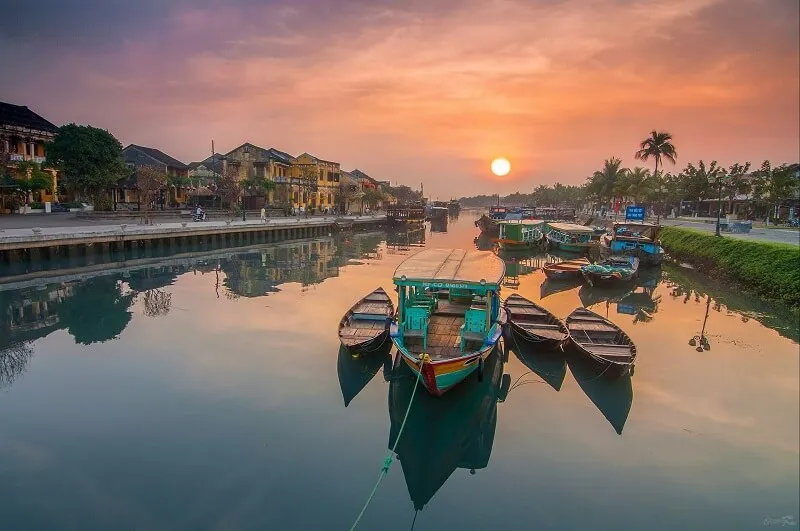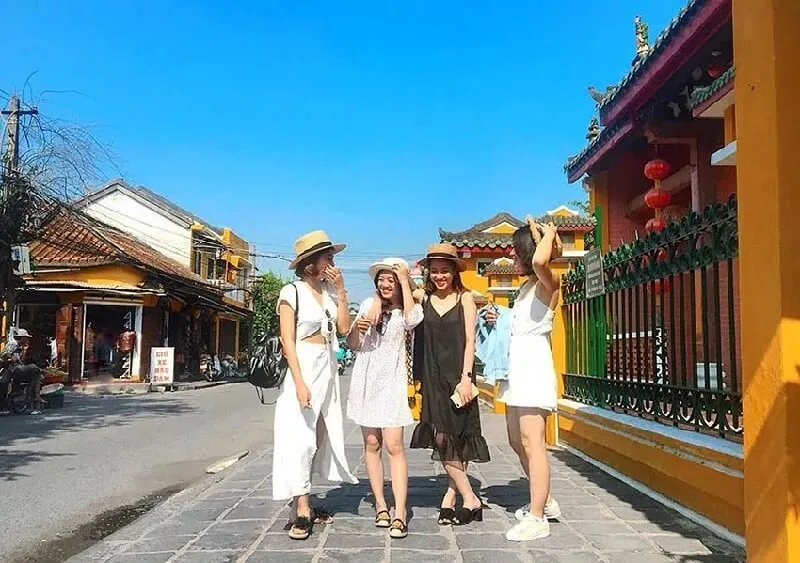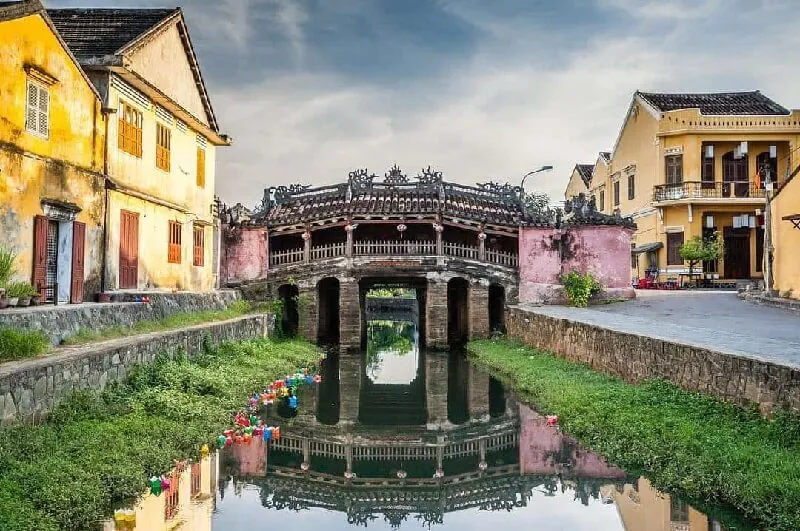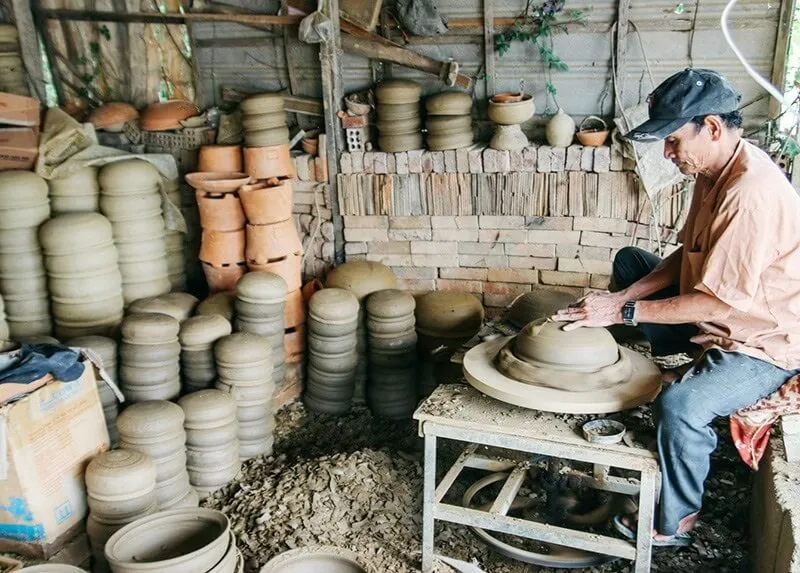Are you dreaming of a self-guided trip to Hoi An but don’t know where to start? From transportation and the ideal time to visit, to must-see attractions, culinary specialties, and unique experiences, meticulous planning is key. This article will share the latest comprehensive Hoi An DIY travel guide, helping you have a fulfilling and memorable journey exploring the ancient town.
Hoi An, a gem of Vietnamese tourism, attracts not only domestic visitors but also captivates international travelers. What makes Hoi An so special? Let’s explore the fascinating aspects and gather useful tips to make your trip even more perfect!
Where is Hoi An? An Overview of the Ancient City
Hoi An is a city in Quang Nam province, located approximately 50km east of Tam Ky city and about 28km southeast of Da Nang. Hoi An Ancient Town, the heart of the city, is situated downstream of the Thu Bon River, in Minh An ward. This area is the center for sightseeing, entertainment, shopping, and a favorite destination for all visitors to Hoi An.

Why is Hoi An Attractive to Tourists?
Hoi An possesses a unique beauty with narrow, winding streets embracing small, classic yellow houses with moss-covered tile roofs. Ancient architectural structures and a shimmering, poetic river blend together, creating a nostalgic and distinctive atmosphere.
Furthermore, Hoi An was once a bustling trading port, a cultural crossroads of many nations, resulting in a diverse and unique culture. Unique traditional festivals and a rich, appealing cuisine are also significant factors contributing to Hoi An’s irresistible charm.
With these exceptional values, Hoi An has been honored with many prestigious titles, most notably the “World Heritage Site” recognition by UNESCO on December 4, 1999.
The Best Time to Travel to Hoi An on Your Own
To have a complete trip, unaffected by bad weather, choosing the right time is crucial. So, when is the best season to visit Hoi An?
Hoi An Climate Characteristics
Hoi An is located in the South Central Coast region, influenced by a tropical monsoon climate with two distinct seasons: the dry season (January – July) and the rainy season (August – December). The average annual temperature fluctuates around 25.6 degrees Celsius.

When Should You Go to Hoi An?
Many believe Hoi An is beautiful in any season, with the rainy season having its own unique charm. However, the ideal time to visit Hoi An is still during the dry season, especially:
- January – March: The weather is cool, the sun is not too harsh, and there is little rain, making it perfect for strolling, sightseeing, and photography.
- April – July: The weather is comfortable, sunny, and clear, favorable for traveling and tourism. However, this is the peak tourist season, and the ancient town gets very crowded, potentially leading to congestion and service scarcity.
From August onwards, Hoi An begins to experience rain, with increasing frequency. In the last months of the year, storms and floods can occur, so be cautious if you plan to visit during this time.
What to Prepare for Your Hoi An DIY Trip?
To ensure a smooth and fulfilling trip, you need to prepare the following carefully:
- Personal documents: ID card/Citizen ID or passport (for international guests), birth certificate (for children under 14 years old).
- Clothing: Choose clothes suitable for the weather and sightseeing locations. Don’t forget swimwear if you want to go to the beach.
- Cash and ATM cards: Bring both for convenient spending.
- Personal items: Sunglasses, sunscreen, hats, umbrellas, long-sleeved jackets (to protect from the harsh sun).
- Medication: Common medications such as motion sickness pills, headache medicine, stomachache medicine, allergy medicine, etc.
- Electronic devices: Phone, camera, power bank, charger cables for taking photos and communication.

How to Get to Hoi An?
Hoi An does not have an airport or train station, so most visitors choose to arrive in Da Nang first and then travel to Hoi An.
How to Get to Da Nang?
- By plane: Most airlines such as Vietnam Airlines, Bamboo Airways, Vietjet Air have flights to Da Nang from major cities.
- By train: You can choose to take the train to Da Nang station, enjoying the scenery along the way and saving costs.
- By bus: Another option is the bus, but the travel time will be quite long (about 15-18 hours).
- By motorbike/Private car: If you are in neighboring provinces, you can travel by motorbike or drive your own car.

How to Get from Da Nang to Hoi An?
- Taxi/Car: If traveling with family or a large group, this is the most convenient option.
- Bus: Cost-effective, but time-consuming and not very flexible.
- Motorbike: Rent a motorbike to freely move around and explore Hoi An at your own pace.
Transportation in Hoi An
In the ancient town area, you can walk or use rudimentary means of transport such as bicycles or cyclos. If you want to travel further, choose one of the following means of transport:
- Rent a bicycle: The feeling of freedom and relaxation when cycling through the streets.

- Cyclo: A fun experience to explore Hoi An slowly and intimately.
- Rent a motorbike: Flexible and proactive in traveling to attractions further away.
- Taxi/Car: Convenient and comfortable, suitable for large groups or families with young children.
- Boat: Rent a boat to explore the Hoai River or travel to islands like Cu Lao Cham.
Explore Famous Tourist Attractions in Hoi An
Hoi An Ancient Town is the tourist center of the city, with ancient houses and unique architectural structures. Here are some of the most prominent places you shouldn’t miss:
- Japanese Covered Bridge (Chua Cau): The symbol of Hoi An, bearing bold Japanese architectural style.

- Tan Ky Old House: “Timeless architectural masterpiece,” a witness to Hoi An’s past and rich culture.
- Phung Hung Old House: More modern and luxurious, combining Japanese, Vietnamese, and Chinese cultures.
- Guangdong Assembly Hall: Admire the elaborate, magnificent, and solemn beauty of the structure built by the Chinese.
- Fujian Assembly Hall: Explore unique architecture, learn about the culture and history of the assembly hall.
- Ba Mu Temple Gate (Tam Quan Gate): A “virtual living” spot favored by young people with its beautiful pink color.
- Hoi An Market: The largest market in the ancient town, selling all kinds of goods from food to souvenirs.
Outside the ancient town, you can explore more places in the suburbs such as:
- Thanh Ha Pottery Village: Learn about the traditional pottery craft and make your own unique pottery products.

- Hoi An Silk Village: Admire ancient beam houses, mulberry gardens, and learn about silkworm farming and silk weaving.
- Tra Que Vegetable Village: Experience the life of a farmer, hoeing the soil, planting vegetables, watering, and harvesting vegetables.
- An Bang Beach: One of the 50 most beautiful beaches in the world, with pristine and peaceful beauty.
- Cua Dai Beach: More vibrant with many recreational sports activities, concentrating many high-class hotels and resorts.
- Old Brick Kiln: A “super cool” check-in spot with steps on the side, located in the middle of vast rice fields.
- Bay Mau Coconut Forest: “The Mekong Delta” in the heart of Hoi An, experience basket boat rides, basket boat dancing performances, and net casting.
- VinWonders Nam Hoi An: An entertainment paradise for all ages, with many thrilling games and a water park area.
Hoi An Night Experiences: Sparkling and Poetic
Hoi An at night has a different beauty, more sparkling and poetic than during the day. Here are some experiences you shouldn’t miss:
- Stroll through the lantern streets: Admire thousands of colorful lanterns, creating a romantic and unique space.
Lantern streets are a distinctive highlight of Hoi An at night, where visitors can admire the sparkling beauty and shop for unique souvenirs.
- Take a boat and release lanterns on the Hoai River: Sit on a boat to admire the ancient town, release lanterns, and send wishes.
- Check-in with bougainvillea trellises and yellow walls: Familiar “virtual living” spots for many young people.
- Enjoy coffee and take photos from above: Admire the panoramic view of Hoi An from rooftop cafes.
- Listen to Bai Choi singing and participate in folk games: Learn about Hoi An’s unique art form.
- Watch the Hoi An Memories Show: The most unique and large-scale art show in Vietnam, recreating Hoi An’s history and culture through traditional ao dai costumes.
Where to Stay When Visiting Hoi An?
The accommodation system in Hoi An is very developed, with many options from homestays, hotels to resorts, from budget to luxury. Depending on your needs and economic conditions, you can choose the appropriate form of accommodation.
- Mid-range hotels: Suitable for exploration trips, not requiring too high amenities.
- 4-5 star hotels, resorts, villas: Ideal choice for family vacations, needing quiet space and high-class amenities.
- Homestays: Suitable for young people who like new and stylish spaces for “virtual living.”
Hoi An Cuisine: A Paradise of Delicious Dishes
Hoi An cuisine is a blend of many cultures, creating unique and attractive dishes. Here are some delicious dishes you must try:
- Quang Noodles (Mi Quang): A specialty of Quang region, with soft white noodles, shrimp, meat, eggs, and rich broth.

- Cao Lau: Thick noodles similar to Japanese udon, Chinese char siu pork, Vietnamese crispy crackers, and fresh herbs, all blended to create a unique dish.
- Hoi An Chicken Rice (Com Ga Hoi An): Fragrant rice cooked with chicken broth, shredded chicken mixed with onions, carrots, Vietnamese coriander, and black pepper sauce.
- Hoi An Bread (Banh Mi Hoi An): Crispy baguette with diverse toppings, pate, butter, pickles, and special sauce.
- Wet Cake Rolls with Grilled Pork (Banh Uot Cuon Thit Nuong): Soft wet rice paper rolls with char-grilled pork skewers, fresh vegetables, peanuts, and sweet and sour dipping sauce.
- White Rose Dumplings (Banh Bao Banh Vac): Fragrant dumplings made from white rice flour, filled with sweet and savory shrimp and meat, very appealing.
What to Buy as Souvenirs When Traveling to Hoi An?
After your trip, you can buy the following specialties as gifts:
- Types of cakes: Green bean cake, gai leaf cake, thuan cake, to cake, xu xe cake, grilled coconut cake,…
- Food products: Thinh fish sauce, Cam Thanh fish sauce, Hoi An chili sauce, Hong Dao wine,…
- Souvenirs: To he toys, lanterns, Hoi An silk, paper fans,…
You can find them at Hoi An Market, Hoi An Night Market, or specialty shops on Tran Phu, Le Loi, Nguyen Hue streets,…
Suggested Hoi An Travel Itineraries
Here are some suggested Hoi An travel itineraries for your reference:
- 2 days 1 night itinerary:
- Day 1: Visit the ancient town, Cua Dai beach, release lanterns on the Hoai River.
- Day 2: VinWonders Nam Hoi An, shopping for specialties as gifts.
- 3 days 2 nights itinerary:
- Day 1: Visit the ancient town, Cua Dai beach, Hoi An night market.
- Day 2: Cu Lao Cham Island, release lanterns on the Hoai River, listen to Bai Choi.
- Day 3: Hoi An Market, check out of the hotel.
- 4 days 3 nights itinerary:
- Day 1: Visit the ancient town, Thanh Ha pottery village, An Bang beach.
- Day 2: Cu Lao Cham, Hoi An night market.
- Day 3: VinWonders Nam Hoi An, transfer to Da Nang.
- Day 4: Da Nang city tour, shopping at Con Market.
Hoi An Travel Costs
Hoi An travel costs depend on many factors such as travel time, hotel, attractions, food,… Below is an estimated cost for a 3-day 2-night trip:
- Plane ticket: 1,000,000 – 1,500,000 VND/person.
- Transportation: 500,000 VND/person.
- Hotel: 350,000 – 650,000 VND/night.
- Food: 600,000 VND/person.
- Entrance fees, entertainment: 650,000 VND/person.
- Souvenirs: 600,000 VND/person.
Total cost: Approximately 4,000,000 – 4,500,000 VND/person.

Important Notes When Traveling to Hoi An
- Mornings in Hoi An are very peaceful, wake up early to enjoy this tranquil atmosphere.
- On the full moon and first day of the lunar month, Hoi An is very crowded, so go early and experience releasing lanterns.
- If traveling during peak season, book services in advance (plane tickets, transportation, hotels) to avoid running out of space and get good prices.
- Monitor weather conditions regularly, especially during the rainy season.
- Be careful when shopping, check prices before buying.
Answering Common Questions About Hoi An Travel
- Are there entrance fees for attractions in Hoi An? Some places are free, but some places require tickets (relics, ancient structures, assembly halls, old houses,…).
- What time does Hoi An Ancient Town close? Activities take place until about 10 PM, while the night market serves until 11 PM.
- Do I need to book a hotel in Hoi An in advance? It is advisable to book in advance, especially during peak season.
- What attractive festivals are there in Hoi An? Ancient Town Full Moon Festival, Ba Thien Hau Festival, Whale Worshiping Festival, Mid-Autumn Festival,…
Hopefully, with these detailed Hoi An DIY travel experiences above, you will have a truly memorable and fulfilling trip! Pack your bags and explore the ancient, peaceful beauty of Hoi An right away!